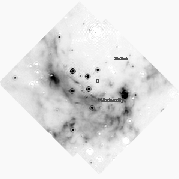
(Image courtesy of M. Rieke)
The Supermassive Black Hole at the Galactic Center
Fulvio Melia (1) & Heino Falcke (2)
(1) Department of Physics & Steward Observatory, University of Arizona, Tucson, AZ 85721 (melia@physics.arizona.edu)(2) Max-Planck-Institut für Radioastronomie, Auf den Hügel 69, D-53121 Bonn, Germany (hfalcke@mpifr-bonn.mpg.de)
Annu. Rev. Astron. Astrophys., Vol. 39, 309-352 (2001)
Preprints: [PostScript (2Mb - reduced quality figures), gzipped PostScript (11Mb - full quality figures), LaTex, BibTeX format (bibliographic database)].Abstract:
The inner few parsecs at the Galactic Center have come under intense scrutiny in recent years, in part due to the exciting broad-band observations of this region, but also because of the growing interest from theorists motivated to study the physics of black hole accretion, magnetized gas dynamics and unusual star formation. The Galactic Center is now known to contain arguably the most compelling supermassive black hole candidate, weighing in at a little over 2.6 million suns. Its interaction with the nearby environment, comprised of clusters of evolved and young stars, a molecular dusty ring, ionized gas streamers, diffuse hot gas, and a hypernova remnant, is providing a wealth of accretion phenomenology and high-energy processes for detailed modeling. In this review, we summarize the latest observational results, and focus on the physical interpretation of the most intriguing object in this region - the compact radio source Sgr A*, thought to be the radiative manifestation of the supermassive black hole.
Paper: Available in PostScript (2Mb - reduced quality figures) or as gzipped PostScript (11Mb - full quality figures) and LaTex. The bibliographic database is also available in BibTeX format. Please send an email request to hfalcke@mpifr-bonn.mpg.de for a preprint.
Other publications can be found here.
Questions: Heino Falcke, hfalcke@mpifr-bonn.mpg.de